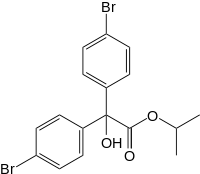Bromopropylate
 | |
| Names | |
|---|---|
| IUPAC name
Isopropyl bis(4-bromophenyl)(hydroxy)acetate | |
| Other names
Acarol; Isopropyl 4,4'-dibromobenzilate; Phenisobromolate | |
| Identifiers | |
| 18181-80-1 | |
| 3D model (Jmol) | Interactive image |
| ChemSpider | 26916 |
| ECHA InfoCard | 100.038.231 |
| PubChem | 28936 |
| |
| |
| Properties | |
| C17H16Br2O3 | |
| Molar mass | 428.12 g·mol−1 |
| Appearance | White solid[1] |
| Density | 1.59 g/cm3 (20 °C)[1] |
| Melting point | 77 °C (171 °F; 350 K)[1] |
| 0.1 mg/L (20 °C)[1] | |
| Except where otherwise noted, data are given for materials in their standard state (at 25 °C [77 °F], 100 kPa). | |
| Infobox references | |
Bromopropylate is a chemical compound used as an acaricide against spider mites in apiaries and on fruit crops such as citrus and grapes.[1]
Preparation
Bromopropylate is prepared by the esterification of the 4,4'-dibromo derivative of benzilic acid with isopropanol.
References
External links
- Bromopropylate, AlanWood.net
This article is issued from Wikipedia - version of the 11/1/2015. The text is available under the Creative Commons Attribution/Share Alike but additional terms may apply for the media files.
